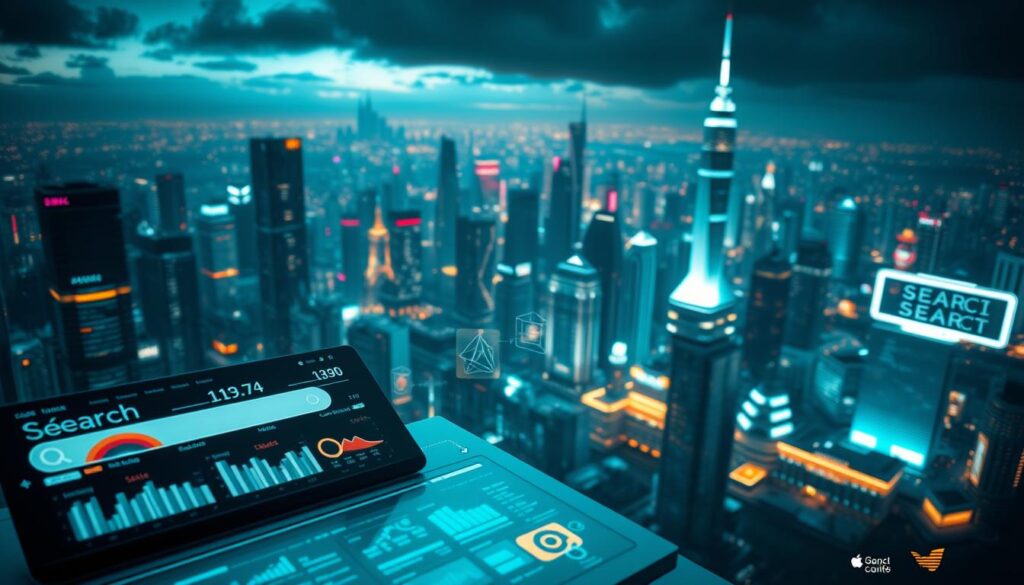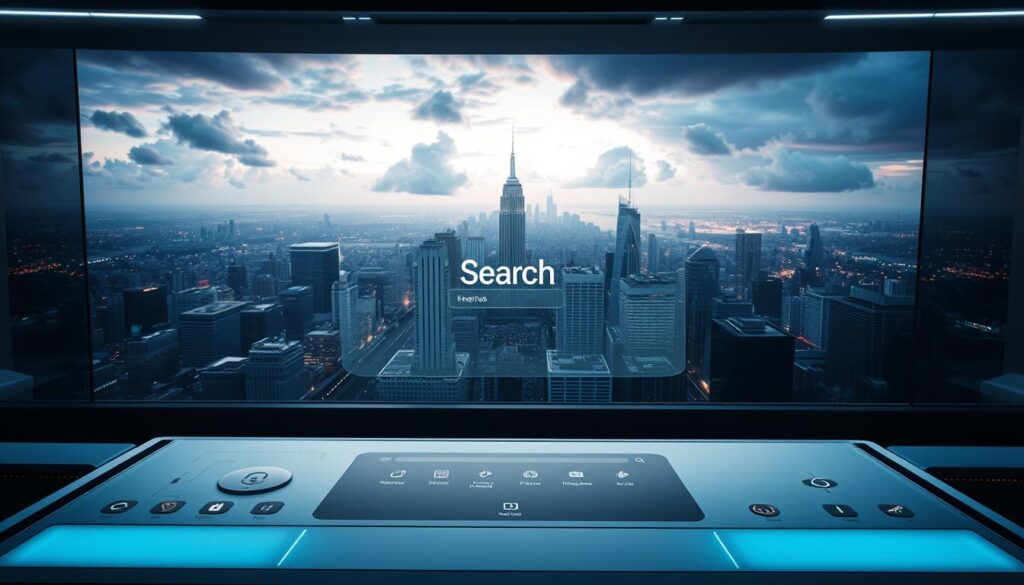Traditional keyword-based queries are becoming relics of the past. Modern systems now process text, images, and audio simultaneously, creating richer interactions. Google’s recent launch of Vertex AI Multimodal Embeddings exemplifies this shift, using vision language models to interpret content holistically.
These systems organize information by semantic meaning, not just keywords. For example, Google’s Contrastive Captioner model analyzes visuals and text with human-like context awareness. This approach has driven over 10% growth in usage for queries with AI Overviews in markets like the U.S. and India.
Enterprise solutions now process millions of documents in real time, boosting productivity. The technology understands relationships between media types, mirroring how people naturally explore ideas. This transforms platforms from retrieval tools to collaborative discovery partners.
Key Takeaways
- Modern systems interpret multiple content types simultaneously, moving beyond text-only queries
- Vision language models enable semantic analysis of images and text together
- Shared embedding spaces organize information by meaning rather than keywords
- Enterprise applications show 10%+ efficiency gains in major markets
- Technology now anticipates user intent through contextual relationships
Introduction: The Changing Landscape of Search

The way users interact with digital platforms has shifted dramatically. Instead of fragmented keyword entries, modern systems interpret complete thoughts and layered questions. This evolution reflects deeper changes in how people seek answers to increasingly complex problems.
Rise of Advanced Language Processing
Natural language understanding now powers platforms to analyze queries conversationally. Users can phrase questions as they’d ask a colleague, with systems identifying context and intent. Average query lengths have doubled in recent years, demonstrating growing user confidence in these capabilities.
Machine learning models continuously refine results by analyzing patterns across billions of interactions. This adaptive approach helps platforms anticipate needs before users fully articulate them. Enterprises report 40% faster decision-making when implementing these systems for internal knowledge management.
Expanding Input Methods
Voice commands and visual searches now complement traditional text inputs. A retail worker might photograph equipment to find repair manuals, while a traveler could describe landmarks to identify locations. These blended approaches mirror how humans naturally process information through multiple senses.
- Conversational queries increased 150% since 2022
- Visual search adoption grew 80% in retail sectors
- 67% of users prefer mixed input methods for complex tasks
This transformation extends beyond consumer applications. Healthcare providers cross-reference medical images with research databases, while manufacturers troubleshoot equipment using voice-activated manuals. The shift toward integrated input methods creates more inclusive, efficient pathways to knowledge discovery.
Deep Dive: Exploring multimodal AI browser search

Advanced systems now decode information through interconnected frameworks that merge visual and linguistic elements. At their core lies a mathematical architecture where images and text coexist in unified dimensional maps, enabling machines to grasp contextual relationships across formats.
Understanding the Technology Behind Cross-Format Embeddings
Three specialized neural networks power this framework. The first processes visual elements like shapes and colors. The second analyzes written descriptions. A third model identifies patterns connecting these formats, creating shared semantic spaces.
Training involves millions of image-text pairs. For instance, a photo of a sunset might pair with phrases like “vibrant horizon colors.” This teaches the system to associate visual patterns with linguistic concepts, forming context-aware intelligence.
| Aspect | Traditional Systems | Modern Embeddings |
|---|---|---|
| Data Processing | Keyword matching | Semantic clustering |
| Input Types | Single format | Mixed media |
| Training Method | Supervised labels | Paired associations |
| Semantic Analysis | Basic pattern recognition | Contextual relationships |
Fixed-dimensional vectors enable rapid comparisons. A 512-number sequence might represent “urban architecture,” allowing quick matches between sketches and building permits. This approach revolutionized advanced AI tools for creative industries.
Real-world implementations show measurable impacts. Retail catalogs using this technology report 35% faster product tagging. Medical databases cross-reference X-rays with research papers 50% more accurately than text-only systems.
Innovations Driving Multimodal Search in Google Cloud

Enterprise technology now demands tools that adapt to diverse data formats while delivering instant results. Google Cloud addresses this through four distinct pathways for implementing cross-format discovery systems. Each solution balances technical complexity with business needs, from plug-and-play interfaces to customizable architectures.
Google Cloud Solutions: Search Website, Vision Warehouse, and Vector Search
Vertex AI Search offers the simplest entry point. Organizations can index web pages or PDFs through a managed service, ideal for teams lacking machine learning experts. Retailers use this to create dynamic catalogs where product descriptions align with visual attributes automatically.
For visual-heavy industries, Vision Warehouse provides API-driven tools to organize millions of images. Media companies track specific items across video archives in seconds. The structured app approach merges traditional databases with semantic matching, useful for financial institutions analyzing mixed-format reports.
Real-Time Capabilities and Scalability in Enterprise Applications
Vector Search powers time-sensitive operations with sub-second query responses. “Latency under 50 milliseconds makes live inventory updates possible during peak sales,” notes a cloud architect at a major e-commerce platform. Streaming updates ensure data freshness without maintenance windows.
Global deployments handle 15 million daily requests across 12 regions. This scalability supports everything from real-time logistics tracking to instant medical image analysis. Performance remains consistent whether users search through 10,000 documents or 10 million video frames.
Business Applications and Enhanced User Experience
Digital marketplaces and industrial systems now harness advanced pattern recognition to transform workflows. Cross-format query systems analyze visual and textual data simultaneously, delivering precise matches across massive databases. This capability reshapes how organizations manage inventories, monitor operations, and develop technologies.
Real-World Use Cases: E-Commerce, Security, and Autonomous Systems
Retail platforms simplify product listings through visual matching. Sellers upload item photos to automatically find similar products, prices, and categories. This eliminates manual tagging while ensuring accurate search results. One platform using these methods reported 40% faster listing processes and improved AI-driven pricing strategies.
Security teams process surveillance feeds using descriptive text commands. Systems flag events like “flooding near equipment” across thousands of live cameras. This reduces response times during emergencies while maintaining 24/7 monitoring accuracy.
Automotive engineers test self-driving systems by locating specific road scenarios in recorded footage. Queries like “pedestrians crossing during red lights” pull relevant clips from petabytes of data. This approach cuts scenario analysis time from weeks to hours.
Enterprise apps demonstrate versatility in quality control. Factories use visual pattern recognition to identify defective items on production lines. Healthcare networks cross-reference medical images with symptom databases, improving diagnostic consistency.
These innovations create intuitive interfaces where users combine text, images, and voice naturally. Reduced search times and higher relevance scores prove these systems’ value across industries.
Future Developments in AI-Powered Search
Next-generation discovery tools are evolving beyond single-format interactions. Systems now analyze video feeds, audio patterns, and text inputs through unified frameworks. This shift enables real-time problem-solving across industries, from academic research to supply chain management.
Intelligent Query Processing and Real-Time Analysis
Modern platforms employ parallel processing techniques to dissect complex requests. AI Mode functionality splits questions into specialized sub-queries, delivering layered insights within seconds. A user researching climate change impacts might receive synthesized data from scientific papers, satellite imagery, and interview transcripts simultaneously.
Live interaction features transform devices into collaborative partners. Pointing a camera at machinery generates instant maintenance guides, while describing sounds identifies music tracks or environmental noises. These systems cross-reference data streams 80% faster than traditional methods, according to recent benchmarks.
Autonomous task handling marks another leap forward. When booking travel, systems compare pricing, seating charts, and cancellation policies across hundreds of options. “The technology acts as a skilled assistant that understands nuanced priorities,” notes a developer at a leading tech firm. This approach reduces decision fatigue while maintaining user control.
Emerging input methods like gesture controls and video analysis tools expand accessibility. Engineers troubleshoot equipment through AR overlays, while shoppers find products using hand-drawn sketches. These innovations demonstrate how intuitive interfaces are reshaping information retrieval.
Conclusion
Visual and textual data now work in tandem to redefine how information connects across industries. Platforms like Google Lens demonstrate this shift, with over 1.5 billion monthly users capturing real-world details through cameras rather than typed queries. Retail innovators like Mercari prove the model’s scalability, delivering millisecond results across 5.8 million product images without metadata.
These systems excel at pattern recognition. Vector-based analysis organizes content by inherent meaning rather than surface labels. This approach streamlines complex tasks – engineers troubleshoot machinery using visual matches, while medical teams cross-reference scans with research databases instantly.
The technology’s true value lies in its adaptability. As seen in advanced reasoning features, platforms now parse layered questions into actionable insights. Users combine sketches, voice notes, and photos seamlessly, mirroring natural human problem-solving methods.
Businesses gain measurable advantages. Faster inventory management, precise quality control, and intuitive conversational interfaces showcase practical applications. These tools don’t just retrieve data – they accelerate discovery through contextual relationships that evolve with each interaction.
This evolution marks a fundamental change in digital exploration. By bridging sensory inputs with machine understanding, modern systems create pathways to knowledge that feel less like tools and more like extensions of human curiosity.







